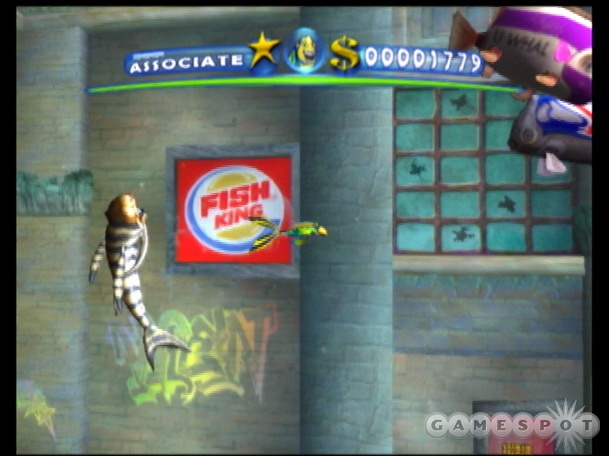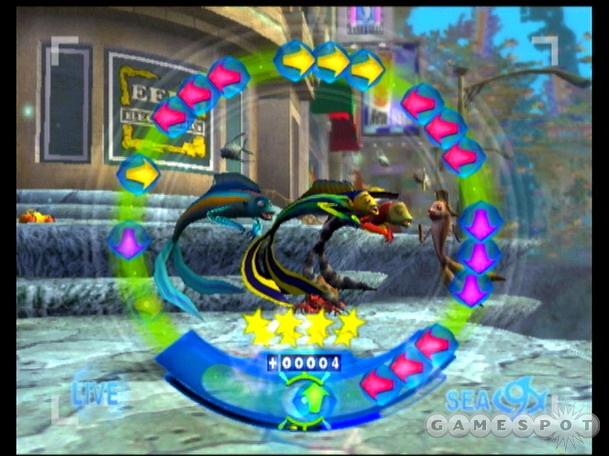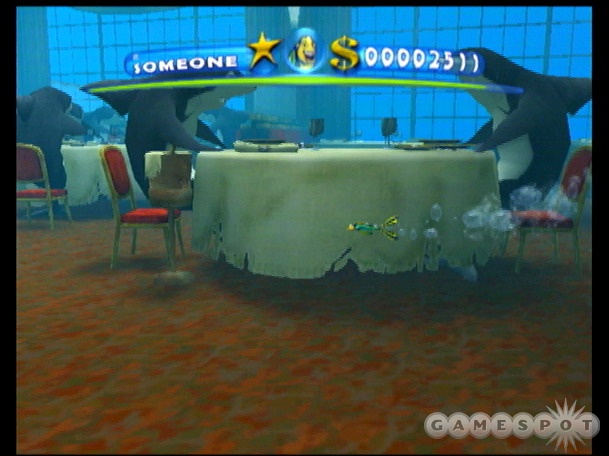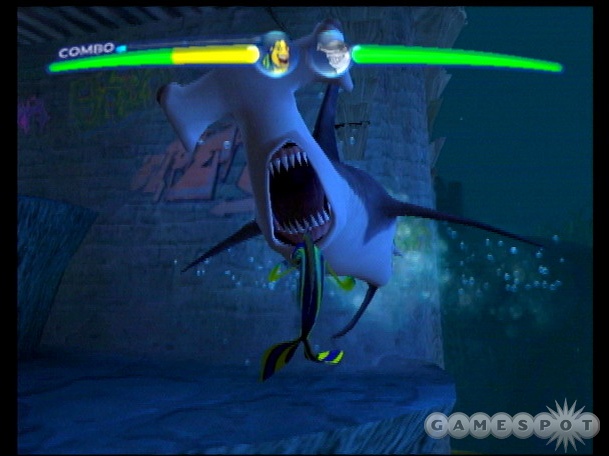Activision's Shark Tale game has a little bit of something for everyone. It's an interactive rendition of the popular animated film that includes swimming-, stealth-, dancing-, race-, chase-, and boxing-oriented levels. The 3D characters and tropical settings are close approximations of their celluloid counterparts, and the production values similarly mimic the film. With the exception of the way the difficulty ramps up during subsequent dancing segments and a few poorly aimed camera angles that lead to nasty surprises here and there, the level designs are relatively straightforward, which, coupled with the easygoing control setup, makes this a good game for folks that primarily just want to relive the movie without racking their brains.

Players assume the role of Oscar, a down-on-his-luck fish who's always coming up with moneymaking schemes that never seem to work out. Early on, we're told that Oscar owes 5,000 clams to a loan shark named Don Lino for gambling debts. Oscar's girlfriend, an angelfish named Angie, gives him an heirloom to sell to pay off the debt. However, Oscar instead uses it to bet on a supposed "sure thing" down at the sea horse track. The "sure thing" loses, and instead of becoming rich, Oscar winds up flat broke, ends up pursued by mob henchmen, and lands himself in the doghouse with Angie. Don Lino then sends his son Lenny after Oscar to make the fish pay up, but Lenny and Oscar end up hitting it off when it's revealed that Lenny is a vegetarian. The two concoct a new scheme that's meant to get both of them off the hook. Lenny and his friends intend to let Oscar beat them up in public, and they further decide to play Oscar up as the world's best shark slayer. This, in turn, will earn Oscar fame and fortune, and it will give Lenny a good excuse to avoid swallowing Oscar. Wackiness ensues as the local paparazzi discover Oscar's secret and try to get the word out. These messes, along with a few other unfortunate snafus, form the basis for each of the game's 25 different levels.
Instead of sticking with one particular style of design for all of the game's levels, such as the standard 3D "adventure" style that most movie-licensed games use, the designers behind Shark Tale incorporated a number of different level concepts that closely reflect the different things that happened in the film. The two most common types of levels involve exploration and pattern matching (dancing). Less common, and perhaps more interesting due to their infrequency, are the levels that involve stealth, race, chase, and boxing situations. Even though each chapter tells the story from the film in a very linear fashion--and each chapter is also bookended by newly-created video clips, in addition to a series of hilarious Dateline-style interviews--no two levels in a row play the same way. Since the game is always switching level styles, you won't get bored doing the same things over and over again.
When Oscar needs to gather a certain number of items or when he quickly needs to visit multiple locations in the city, you'll end up playing an exploration stage. These typically involve swimming through mazelike areas while using Oscar's dash attack to either knock out enemy fish or break open boxes containing useful items. Enemy fish, such as anglers and piranhas, will try to bite Oscar, and you can also lose stamina by running into puffed up puffer fish or spiky sea urchins. The method for regaining health is hilarious. When you want to replenish Oscar's health, all you need to do is swim next to a door and knock on it, which then causes Oscar to barge into the person's (or fish's) home. Oscar then sits down for a quick meal. All of the characters, buildings, and structures in these stages look three dimensional, but movement is generally restricted to a two-dimensional plane. The camera angle changes at various intervals to depict a fresh perspective that's similar to the way games like Namco's Klonoa 2 or Capcom's Viewtiful Joe use shifting cameras to make their two-dimensional play seem three dimensional.

Some missions call for sneaking past police dolphins or mob sharks without being seen or, at the very least, staying out of sight as much as possible to minimize the number of times a piranha takes a bite out of Oscar's tail fin. These stealth missions are similar to the exploration missions, except that you can make Oscar hide behind certain structures (such as coral, mailboxes, and lampposts) by pressing the action button. When a police dolphin passes by or a shark turns its back, you can tap the action button again to pop back into the foreground to continue on your way. While hidden, the analog stick lets you tilt the camera farther to the left or right to get a better view of what's around you. Most of the time, these stealth missions are a breeze, because the enemy's patrol patterns are easy to figure out, and the camera does a great job of showing what's up ahead. Once in a while, however--and perhaps because the developers wanted to make things more challenging--the camera viewpoint will move closer to Oscar, and it will show less of what's up ahead as a result. In these instances, it's possible to dash past one patrolling shark only to run into another one a few inches away from you that you didn't know was there. These surprises are aggravating when they happen, but, thankfully, they don't happen too often.
In the film, Oscar would often break into song and dance to either impress a group of people or put on a performance for one of his sponsors. These situations are duplicated in the game by a series of pattern-matching levels that are set up in a manner similar to Konami's Dance Dance Revolution games. While the music plays and Oscar shakes his groove thang in the middle of the screen, various arrow symbols rotate clockwise and pass through a circle at the bottom of the screen. You earn points by pushing the indicated buttons when they pass through the circle, and you lose points by failing to do so. The PlayStation 2 and Xbox versions of the game support the use of dance mat peripherals for the dancing segments. Certain arrow combinations are easier to perform on a dance mat, but the arrow patterns don't add up into choreographed dances like the patterns in Dance Dance Revolution do, so using a mat doesn't really enhance the overall experience. One problem with the dancing stages is that, while the length and difficulty of most levels in the game ramp up gradually--from mild to moderate--the speed and complexity of the arrow patterns in each subsequent dance level increase by leaps and bounds. If you end up replaying a level over and over again, chances are it'll involve dancing. It's fairly obvious that the developers implemented these dancing stages primarily as a means to feature specific songs from the movie, namely MC Hammer's "U Can't Touch This" and Outkast's "The Way You Move." Nonetheless, however, they provide a good diversion from the game's other levels.
The other levels in the game depict race, chase, and boxing situations by using the same third-person, behind-the-fish camera viewpoint. They're all designed to be simple and easy to play. During a race, you have to beat your opponent across the finish line or reach the end of the course before time runs out. You can steer Oscar by using the analog stick, and you can make him accelerate or slow down by pushing the controller buttons. That's the extent of the controls. The courses run through large underwater cities, but, with the exception of a few indicated shortcuts, you can't actually go off course. Running into other fish or objects will slow Oscar down, though. You also get bonus points for collecting or smashing certain items along the way. In general, the camera does a good job of keeping up with Oscar, and the frame rate is smooth enough so that you can make out hazardous objects long before they're close enough to hurt him. The viewpoint is pointed at a slight downward angle instead of straight ahead, which makes it difficult sometimes to get through a cave entrance without running into its lip. However, this only poses a problem in the game's last level, which is a grueling, uncompromising test of reflexes that absolutely has to be completed perfectly to be completed at all.

Chase levels borrow a page from the old Dragon's Lair schematic. In these stages, Oscar automatically swims as fast as he can while being pursued by some giant fish, which is usually a shark. When the shark opens its mouth to attack, an arrow appears indicating that the left, right, top, or bottom portion of the screen will offer safe haven from the shark's bite. The goal here is to press in the direction of the arrow when it appears. The boxing stages take the chase stage setup one step further. After you dodge an attack, you can press a controller button to make Oscar punch and kick the shark, or you can push two buttons simultaneously to perform a special attack. If you land a handful of attacks in a row, the shark will be stunned for a short time, and you'll be able to chain together multiple attacks into a high-scoring combination. None of these various levels are all that complicated, but they each add to the overall diversity of the game, and they keep it from getting too boring or repetitive.
Most people, no matter how young or inexperienced, will have no problem finishing the game within a day or two, despite the frustrations posed by the last couple of dancing stages and the final race level. There's more to Shark Tale than just finishing it, however. Besides the main goal presented for each mission, every mission also has a pair of bonus goals that you can try to complete to boost Oscar's fame ranking. Bonus goals range from simple things, like collecting a certain number of pearls or getting through the level within a set time, to tougher tasks, like completing a chase stage without getting bitten or making it through a stealth level without being seen once. There is an "extras" menu that's full of hundreds of cool bonuses that you can buy using the pearls you've collected throughout the game, but the items that are available for purchase are based on Oscar's fame ranking. A higher rank means you can buy more items. Extras include movie posters, film clips, concept art, character animatics, game clips, and a music player that features compositions from the game as well as some of the pop and hip-hop songs that were used in the movie.
There's also something to be said for how nicely the game captures the look and feel of the movie it's based on. The 3D character models and environments are spitting images of the characters and locations from the film. If you've seen the movie, you'll recognize places like the Whale Wash and Yellowtail Sushi. The variety of different animations and gestures isn't particularly good, and the backgrounds don't exhibit nearly as much fine detail as you're used to seeing in other adventure games (especially on the Xbox), but the animations that are there are pretty amusing, and the frame rate is silky smooth, even when hundreds of pedestrian fish are cluttering the screen. One aspect that words and screen captures can't get across sufficiently is how lively the environments are. All over the place, there are fish swimming around and bubbles drifting up to the surface, and the entire screen has a rhythmic distortion to it that's indicative of how things might be seen underwater. These aspects are impossible to notice in static screen captures, and thus they don't fully express the full magnitude of the game's undersea look.

Will Smith, who voiced Oscar on the big screen, doesn't provide the voice for the game, but the actor who has taken his place sounds terrific. Whether it's the short witticisms that Oscar utters when he loses some health or whether it's the lengthy diatribes he spouts off during the cinematic cutaways, a Fresh Prince-like personality comes through in the portrayal of the character. All of the voice actors contribute brief comments and larger chunks of dialogue that never seem wooden or detached. The soundtrack is a combination of original compositions made just for the game and some of the pop songs that were used in the movie. Notable examples include MC Hammer's "U Can't Touch This," Inner Circle's "Bad Boys" theme, Outkast's "The Way You Move," the Fat Boys and Beach Boys' 1986 cover of "Wipeout," and Will Smith's own Shark Tale theme song.
Objectively speaking, Shark Tale doesn't bring anything to the table that hasn't already been brought to it before--and sometimes in a grander fashion --in other adventure games. Nevertheless, this is a game that fans of the film will likely enjoy, first, because the diverse assortment of different levels keeps the hands-on experience fresh, and second, because so much of the actual footage, music, and dialogue from the movie has been woven so generously into the game.